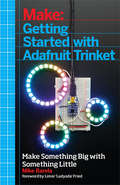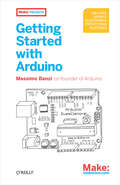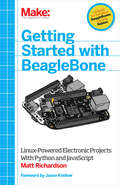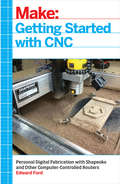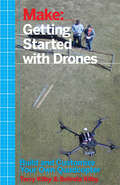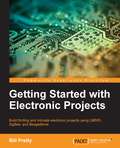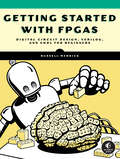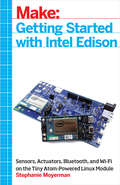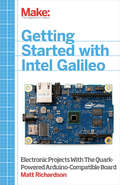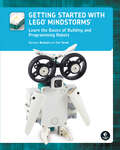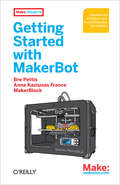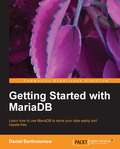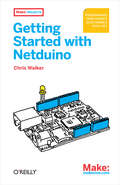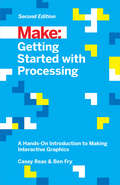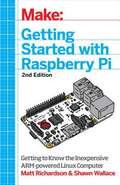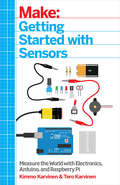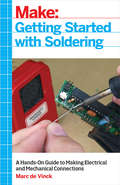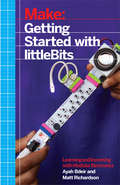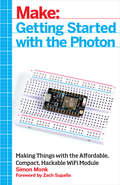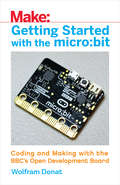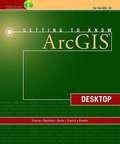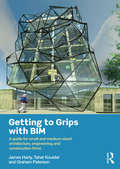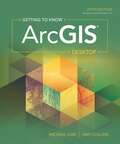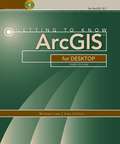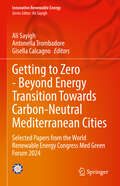- Table View
- List View
Getting Started with Adafruit Trinket: 15 Projects with the Low-Cost AVR ATtiny85 Board
by Mike BarelaArduino's ubiquity and simplicity has led to a gigantic surge in the use of microcontrollers to build programmable electronics project. Despite the low cost of Arduino, you're still committing about $30 worth of hardware every time you build a project that has an Arduino inside. This is where Adafruit's Trinket comes in. Arduino-compatible, one-third the price, and low-power, the Trinket lets you make inexpensive and powerful programmable electronic projects. Written by one of the authors of Adafruit's Trinket documentation, Getting Started with Trinket gets you up and running quickly with this board, and gives you some great projects to inspire your own creations.
Getting Started with Arduino: The Open Source Electronics Prototyping Platform (Make: Projects)
by Massimo BanziThis valuable little book offers a thorough introduction to the open-source electronics prototyping platform that's taking the design and hobbyist world by storm. Getting Started with Arduino gives you lots of ideas for Arduino projects and helps you get going on them right away. From getting organized to putting the final touches on your prototype, all the information you need is right in the book. Inside, you'll learn about:Interaction design and physical computingThe Arduino hardware and software development environmentBasics of electricity and electronicsPrototyping on a solderless breadboardDrawing a schematic diagramAnd more. With inexpensive hardware and open-source software components that you can download free, getting started with Arduino is a snap. To use the introductory examples in this book, all you need is a USB Arduino, USB A-B cable, and an LED.Join the tens of thousands of hobbyists who have discovered this incredible (and educational) platform. Written by the co-founder of the Arduino project, with illustrations by Elisa Canducci, Getting Started with Arduino gets you in on the fun! This 128-page book is a greatly expanded follow-up to the author's original short PDF that's available on the Arduino website.
Getting Started with BeagleBone: Linux-Powered Electronic Projects With Python and JavaScript
by Matt RichardsonMany people think of Linux as a computer operating system, running on users' desktops and powering servers. But Linux can also be found inside many consumer electronics devices. Whether they're the brains of a cell phone, cable box, or exercise bike, embedded Linux systems blur the distinction between computer and device. Many makers love microcontroller platforms such as Arduino, but as the complexity increases in their projects, they need more power for applications, such as computer vision. The BeagleBone is an embedded Linux board for makers. It's got built-in networking, many inputs and outputs, and a fast processor to handle demanding tasks. This book introduces you to both the original BeagleBone and the new BeagleBone Black and gets you started with projects that take advantage of the board's processing power and its ability to interface with the outside world.
Getting Started with CNC: Personal Digital Fabrication with Shapeoko and Other Computer-Controlled Routers
by Edward FordGetting Started with CNC is the definitive introduction to working with affordable desktop and benchtop CNCs, written by the creator of the popular open hardware CNC, the Shapeoko. Accessible 3D printing introduced the masses to computer-controlled additive fabrication. But the flip side of that is subtractive fabrication: instead of adding material to create a shape like a 3D printer does, a CNC starts with a solid piece of material and takes away from it. Although inexpensive 3D printers can make great things with plastic, a CNC can carve highly durable pieces out of a block of aluminum, wood, and other materials. This book covers the fundamentals of designing for--and working with--affordable ($500-$3000) CNCs.
Getting Started with Drones: Build and Customize Your Own Quadcopter
by Belinda Kilby Terry KilbyWant to make something that can fly? How about a flying robot? In this book, you'll learn how drones work, how to solve some of the engineering challenges a drone presents, and how to build your own--an autonomous quadcopter that you can build, customize, and fly. Your drone will be your eyes in the sky and in places where a human could never get to-much less fit!
Getting Started with Electronic Projects
by Bill PrettyThis book is aimed at hobbyists with basic knowledge of electronics circuits. Whether you are a novice electronics project builder, a ham radio enthusiast, or a BeagleBone tinkerer, you will love this book.
Getting Started with FPGAs: Digital Circuit Design, Verilog, and VHDL for Beginners
by Russell MerrickSkip the complexity and learn to program FPGAs the easy way through this hands-on, beginner-friendly introduction to digital circuit design with Verilog and VHDL.Whether you have been toying with field programmable gate arrays (FPGAs) for years or are completely new to these reprogrammable devices, this book will teach you to think like an FPGA engineer and develop reliable designs with confidence.Through detailed code examples, patient explanations, and hands-on projects, Getting Started with FPGAs will actually get you started. Russell Merrick, creator of the popular blog Nandland.com, will guide you through the basics of digital logic, look-up tables, and flip-flops, as well as high-level concepts like state machines. You&’ll explore the fundamentals of the FPGA build process including simulation, synthesis, and place and route.You&’ll learn about key FPGA primitives, such as DSP blocks and PLLs, and examine how FPGAs handle math operations and I/O.Code examples are provided in both Verilog and VHDL, making the book a valuable resource no matter your language of choice. You&’ll discover how to:Implement common design building blocks like multiplexers, LFSRs, and FIFOsCross between clock domains without triggering metastable conditions or timing errorsAvoid common pitfalls when performing mathTransmit and receive data at lightning speeds using SerDesWrite testbench code to verify your designs are workingWith this accessible, hands-on guide, you&’ll be creating your own functional FPGA projects in no time. Getting started with FPGAs has never been easier.
Getting Started with Intel Edison: Sensors, Actuators, Bluetooth, and Wi-Fi on the Tiny Atom-Powered Linux Module
by Stephanie MoyermanThe Intel Edison is a crowning achievement of Intel's adaptation of its technology into maker-friendly products. They've packed the dual-core power of the Atom CPU, combined it with a sideboard microcontroller brain, and added in Wi-Fi, Bluetooth Low Energy, and a generous amount of RAM (1GB) and flash storage (4GB). This book, written by Stephanie Moyerman, a research scientist with Intel's Smart Device Innovation Team, teaches you everything you need to know to get started making things with Edison, the compact and powerful Internet of Things platform. Projects and tutorials include: Controlling devices over BluetoothUsing Python and Arduino programming environments on EdisonTracking objects with a webcam and OpenCVResponding to voice commands and talking backUsing and configuring Linux on Edison
Getting Started with Intel Galileo: Electronic Projects with the Quark-Powered Arduino-Compatible Board
by Matt RichardsonGetting Started with the Intel Galileo gets you up and running with this new, x86-powered board that was developed in collaboration between Arduino and Intel. You'll learn how to set it up, connect it to your computer, and begin programming. You'll learn how to build electronics projects around the Galileo, and you'll explore the features and power that make it different from all the boards that came before.Developed in collaboration with the Intel Galileo team, and in consultation with members of the Arduino team, this is the definitive introduction to Intel's new board for makers.
Getting Started with LEGO® MINDSTORMS: Learn the Basics of Building and Programming Robots
by Barbara Bratzel Rob TorokA hands-on, beginner-friendly guide to building and programming robots with LEGO® MINDSTORMS Robot Inventor and LEGO® SPIKE Prime.You&’re the new owner of a LEGO® MINDSTORMS Robot Inventor or SPIKE Prime kit. Now what? This full-color, illustrated instructional guide teaches you the basics of robotics engineering, using examples relevant to both LEGO® sets. You&’ll be making remote-control vehicles, motorized grabbers, automatic ball launchers, and other exciting robots in no time!Rather than feature step-by-step instructions for building a handful of models, you&’ll find essential information and expert tips and tricks for designing, building, and programming your own robotic creations. The book features a comprehensive introduction to coding with Word Blocks, an intuitive visual programming language based on Scratch, and explores topics such as using motors and sensors, building sturdy structures, and troubleshooting problems when things go wrong. As you learn, loads of challenges and open-ended projects will inspire you to try out ideas. Your journey to becoming a confident robot designer begins here.
Getting Started with MakerBot: A Hands-On Introduction to Affordable 3D Printing
by Bre Pettis Jay Shergill Anna Kaziunas FranceReady to join the personal fabrication movement? This hands-on book shows you how to make a wide variety of physical objects with the amazing MakerBot 3D printer.It’s handy when you need a replacement for something lost, broken, or no longer made—like a knob on your stove. You can make things instead of buying them, or solve problems with inventions of your own. The possibilities are endless, and MakerBot is the fun, affordable, and inspiring way to go. Get started with your own little factory today!Set up your MakerBot Replicator 2 and understand how it worksLearn the basics and print 10 useful objects right awayMake objects with sturdy yet biodegradable PLAGet examples of real-world problem solving, from ceiling hooks to hermit crab shellsChoose from thousands of free designs on Thingiverse.com—and share your ownRepurpose disposable products by making them part of your designDesign your own 3D objects, using SketchUp, Autodesk 123D, OpenSCAD, and other toolsUse 3D scanning technology to replicate real objects around you
Getting Started with MariaDB
by Daniel BartholomewA practical, hands-on, beginner-friendly guide to installing and using MariaDB.Getting Started with MariaDB is for anyone who wants to learn more about databases in general or MariaDB in particular. No prior database experience is required. It is assumed that you have basic knowledge of software installation, editing files with a text editor, and using the command line and terminal.
Getting Started with Netduino: Open Source Electronics Projects with .NET
by Chris WalkerStart building electronics projects with Netduino, the popular open source hardware platform that’s captured the imagination of makers and hobbyists worldwide. This easy-to-follow book provides the step-by-step guidance you need to experiment with Netduino and the .NET Micro Framework.Through a set of simple projects, you’ll learn how to create electronic gadgets—including networked devices that communicate over TCP/IP. Along the way, hobbyists will pick up the basics of .NET programming, and programmers will discover how to work with electronics and microcontrollers. Follow the projects in sequence and learn techniques for building your own Netduino-based devices.Get an overview of the Netduino microcontroller familyInstall the free Visual Studio Express, .NET Micro Framework, and Netduino SDKWrite code that lets you turn Netduino’s LED on and offLearn how to increase Netduino’s capabilities with various expansion shieldsMeasure digital and analog inputs with MakerShieldMake a light appear dimmer or brighter with Pulse Width ModulationUse electrical pulses to play a song and control the position of a servo motorCreate an app to control your Netduino over the Web
Getting Started with Processing: A Hands-On Introduction to Making Interactive Graphics
by Ben Fry Casey ReasProcessing opened up the world of programming to artists, designers, educators, and beginners. This short book gently introduces the core concepts of computer programming and working with Processing. Written by the co-founders of the Processing project, Reas and Fry, Getting Started with Processing shows you how easy it is to make software and systems with interactive graphics. If you're an artist looking to develop interactive graphics programs or a programmer on your way to becoming an artist, this book will take you where you want to go. Updated with new material on graphics manipulation, data, and for the latest version of Processing.
Getting Started with Raspberry Pi
by Shawn Wallace Matt RichardsonWhat can you do with the Raspberry Pi, a $35 computer the size of a credit card? All sorts of things! If you're learning how to program, or looking to build new electronic projects, this hands-on guide will show you just how valuable this flexible little platform can be. This book takes you step-by-step through many fun and educational possibilities. Take advantage of several preloaded programming languages. Use the Raspberry Pi with Arduino. Create Internet-connected projects. Play with multimedia. With Raspberry Pi, you can do all of this and more. Get acquainted with hardware features on the Pi's board Learn enough Linux to move around the operating system Pick up the basics of Python and Scratch--and start programming Draw graphics, play sounds, and handle mouse events with the Pygame framework Use the Pi's input and output pins to do some hardware hacking Discover how Arduino and the Raspberry Pi complement each other Integrate USB webcams and other peripherals into your projects Create your own Pi-based web server with Python
Getting Started with Sensors: Measure the World with Electronics, Arduino, and Raspberry Pi
by Tero Karvinen Kimmo KarvinenTo build electronic projects that can sense the physical world, you need to build circuits based around sensors: electronic components that react to physical phenomena by sending an electrical signal. Even with only basic electronic components, you can build useful and educational sensor projects.But if you incorporate Arduino or Raspberry Pi into your project, you can build much more sophisticated projects that can react in interesting ways and even connect to the Internet. This book starts by teaching you the basic electronic circuits to read and react to a sensor. It then goes on to show how to use Arduino to develop sensor systems, and wraps up by teaching you how to build sensor projects with the Linux-powered Raspberry Pi.
Getting Started with Soldering: A Hands-On Guide to Making Electrical and Mechanical Connections
by Marc De VinckGetting Started with Soldering not only teaches new makers and experimenters the core principles of soldering, it also functions as an excellent reference and resource for beginners and more advanced makers alike. The book guides readers through the fundamentals of soldering, explains the tools and materials, demonstrates proper techniques, and shows how to fix mistakes or broken connections. It even includes guidance on more advanced techniques such as surface-mount soldering for electronics. From choosing the right soldering iron to making perfect connections, readers will acquire the knowledge and skills needed to form a strong foundation for a lifetime of making.Soldering is a core concept in making, electronics prototyping, and home repairsThe many different types of soldering -- requiring different materials and tools -- are explained with easy-to-follow instructionsFull-color photographs and illustrations throughout create a visually engaging format for learningPricing and technical considerations help readers select the best tools for their budgets and needsTroubleshooting guidelines show how to repair solder connections that have failed from improper technique or from age
Getting Started with littleBits: Prototyping and Inventing with Modular Electronics
by Matt Richardson Ayah BdeirlittleBits are electronic building blocks with over 60 modules and trillions of combinations. With littleBits, anyone can harness the power of electronics, microcontrollers, and the cloud--regardless of age, gender, technical ability, or educational background. You can combine these simple, snap-together, magnetic bricks to make simple electronic circuits, or build robots and devices that combine sensors, microcontrollers, and cloud connectivity. This book, co-authored by littleBits founder Ayah Bdeir, along with top-selling author Matt Richardson (Getting Started with Raspberry Pi), teaches you just enough electronics to start making things with littleBits and takes you on up through connecting littleBits to the cloud and programming with its Arduino-compatible module.
Getting Started with the Photon: Making Things with the Affordable, Compact, Hackable WiFi Module
by Simon MonkThe Photon is an open source, inexpensive, programmable, WiFi-enabled module for building connected projects and prototypes. Powered by an ARM Cortex-M3 microcontroller and a Broadcom WiFi chip, the Photon is just as happy plugged into a hobbyist's breadboard as it is into a product rolling off of an assembly line. While the Photon--and its accompanying cloud platform--is designed as a ready-to-go foundation for product developers and manufacturers, it's great for Maker projects, as you'll see in this book. You'll learn how to get started with the free development tools, deploy your sketches over WiFi, and build electronic projects that take advantage of the Photon's processing power, cloud platform, and input/output pins. What's more, the Photon is backward-compatible with its predecessor, the Spark Core.
Getting Started with the micro: Coding and Making with the BBC's Open Development Board
by Wolfram DonatThe micro:bit, a tiny computer being distributed by the BBC to students all over the UK, is now available for anyone to purchase and play with. Its small size and low power requirements make it an ideal project platform for hobbyists and makers. You don't have to be limited by the web-based programming solutions, however: the hardware on the board is deceptively powerful, and this book will teach you how to really harness the power of the micro:bit. You'll learn about sensors, Bluetooth communications, and embedded operating systems, and along the way you'll develop an understanding of the next big thing in computers: the Internet of Things.
Getting To Know ArcGIS Desktop
by Tim Ormsby Eileen J. Napoleon Robert Burke Carolyn Groessl Laura BowdenGetting to Know ArcGIS Desktop introduces principles of GIS as it teaches the mechanics of using ESRI's leading technology. Key concepts are combined with detailed illustrations and step-by-step exercises to acquaint readers with the building blocks of ArcGIS Desktop including ArcMap", for displaying and querying maps, ArcCatalog", for organizing geographic data, and Model Builder", for diagramming and processing solutions to complex spatial analysis problems. Its broad scope, simple style, and practical orientation make this book an ideal classroom text and an excellent resource for those learning GIS on their own. A data CD for working through the exercises and a fully functioning 180-day trial ArcGIS Desktop 10 software is included.
Getting to Grips with BIM: A Guide for Small and Medium-Sized Architecture, Engineering and Construction Firms
by James Harty Tahar Kouider Graham PatersonWith the UK government‘s 2016 BIM threshold approaching, support for small organisations on interpreting, filtering and applying BIM protocols and standards is urgently required. Many small UK construction industry supply chain firms are uncertain about what Level 2 BIM involves and are unsure about taking first steps towards having BIM capability. As digitisation, increasingly impacts on work practices, Getting to Grips with BIM offers an insight into an industry in change supplemented by practical guidance on managing the transition towards more widespread and integrated use of digital tools to manage the design, construction and whole life use of buildings.
Getting to Know ArcGIS Desktop (Getting to Know ArcGIS)
by Michael Law Amy CollinsBecoming the go-to person for ArcGIS Desktop? Start here. <p><p> This book is a comprehensive introduction to the features and tools of ArcGIS Desktop. Through hands-on exercises, readers will discover, use, make, and share maps with meaningful content. They will also learn how to build geodatabases, query data, analyze geospatial data, and more. The latest edition has been updated to the most current version of ArcGIS Desktop 10.6. <p><p> This book is suited for classroom use, independent study, and as a reference.
Getting to Know ArcGIS for Desktop (Getting to Know ArcGIS Series)
by Michael Law Amy CollinsGetting to Know ArcGIS for Desktop is a workbook for beginners. Its detailed, step-by-step exercises teach you the core functionality of ArcGIS for Desktop software: how to make maps, carry out spatial analysis, and build and edit spatial databases in the context of realistic projects. The exercises are supported by conceptual discussions at the start of each chapter and as needed throughout the book. Getting to Know ArcGIS for Desktop is a hands-on workbook that’s meant to be a practical manual for classroom lab work or on-the-job training. If you have no GIS background, chapter 1 will give you a quick overview. If you have no ArcGIS software experience, chapter 2 will provide a background on Esri GIS software products. The remaining 18 chapters require you to work through software exercises as you read. Each of these chapters contains two to four exercises that focus on a particular GIS task or problem. Many common tasks are covered, including navigating digital maps, finding GIS data online, setting map projections, symbolizing and labeling maps, classifying data, making map layouts, querying maps, analyzing spatial relationships, building spatial databases, editing data, and geocoding addresses. Each new exercise in Getting to Know ArcGIS for Desktop is a fresh starting point, with the maps and data you need already prepared for you. This volume is heavily revised for the third edition. New authors Michael Law and Amy Collins replaced a majority of the datasets for a fresh learning experience. All the exercises were designed for compatibility with ArcGIS 10.1 for Desktop. Although still intended for beginners, the content is no longer limited to the most basic functionality. Some advanced capabilities that are available with Standard and Advanced licenses are discussed. As the chapters progress, instructions and graphics become noticeably more streamlined, assuming increased knowledge and recall by readers as they move forward. Several new features have been added to the book to enhance the learning experience: learning objectives, chapter summaries, questions for critical thinking, software tips, independent-challenge tasks (“On your own"), a glossary of key terms, and navigation tabs.
Getting to Zero - Beyond Energy Transition Towards Carbon-Neutral Mediterranean Cities: Selected Papers from the World Renewable Energy Congress Med Green Forum 2024 (Innovative Renewable Energy)
by Ali Sayigh Antonella Trombadore Gisella CalcagnoThis book contains selected papers from the World Renewable Energy Congress and Network Forum's seventh edition of the biannual Med Green Forum (MGF2024) that highlight opportunities for energy transition based on the principles of efficiency, urban/building integration, and ecology. Contributions explore possible carbon-neutral solutions, technologies, strategies, processes, and policies for Mediterranean cities. The book addresses the transformation in the unique socio-climatic and cultural context of the Mediterranean basin, cities, and architecture, a transversal topic deeply related to social dynamics and new energy landscapes.
